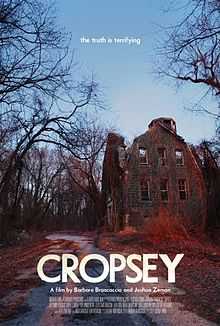Cropsey (film)
| Cropsey | |
|---|---|
 Theatrical Release Poster | |
| Directed by |
Joshua Zeman Barbara Brancaccio |
| Produced by |
Joshua Zeman Barbara Brancaccio Zachary Mortensen |
| Written by | Joshua Zeman |
| Music by | Alexander Lasarenko |
| Cinematography | Chad Davidson |
| Edited by | Tom Patterson |
Production company |
Antidote Films Afterhours Productions Ghost Robot Off Hollywood Pictures (in association) |
| Distributed by |
Cinema Purgatorio (theatrical) Breaking Glass Pictures (2011, DVD) |
Release dates |
|
Running time | 84 minutes |
| Country | United States |
| Language | English |
Cropsey is a 2009 American documentary film written and directed by Joshua Zeman and Barbara Brancaccio. The film initially begins as an examination of "Cropsey," a boogeyman-like figure from New York urban legend, before segueing into the story of Andre Rand, a convicted child kidnapper from Staten Island.
In 2009, Cropsey premiered at the Tribeca Film Festival, where programmer David Kwok stated, “The eeriness of the mystery pulsates through the film as they journey into the underbelly… As more information and clues unravel, Zeman and Brancaccio become more immersed in shocking surprises and revelations. The reality they uncover in this uniquely hair-raising documentary is more terrifying than any urban legend.”[1]
Cropsey origins
The name "Cropsey"[2] has nebulous origins. At the time of the kidnappings depicted in the documentary, Cropsey had come to be New York vernacular for any psychotically violent criminal. One of the detectives interviewed in the film suggests that this generic label was used enough to frighten children that the name came to refer to an idea of a particular individual rather than a simple archetype.
Contact with Andre Rand
When filming began, Zeman and Brancaccio sent Andre Rand a letter. After not receiving a response for approximately a month, they decided to visit him directly at Rikers Island. On the day they were going to Rikers, they received the reply. After a series of letter exchanges, Rand agreed to an interview. However, by the time the filmmakers arrived at the prison, Rand had changed his mind and declined an interview.
Production
Upon shooting their research of the origins of the missing kids’ stories, Zeman and Brancaccio realized that the truth did not dwindle into something concrete; instead, it expanded into something large and convoluted. What began as Jennifer’s missing story became an in depth investigation of five missing children’s stories. The objective was to bring the distinct elements into one overarching narrative: the oral tradition of urban legends; the mystery of the missing children; the courtroom drama; the search for the roots of Staten Island’s obsession with the case, the community’s need for catharsis.
Andre Rand’s court case did not start for four years after his indictment, which was one of the longest pre-trial motions in New York State history. The culmination of the film alludes to indicting Rand, which became controversial.
Reception
Cropsey received an 90% rating from Rotten Tomatoes.[3] Metacritic gave the film a score of 73 which is considered "generally favorable".[4]
Awards
- Hammer to Nail: 2009 Tribeca’s Grand Jury Prize.[5]
- IndieWIRE’s 2009 Best Undistributed Film list, Annual Critics Survey.[6]
- Closing Night Film, SF Documentary Festival.[7]
- Audience Award Winner, Staten Island Film Festival.[8]
See also
- The Burning, a 1981 horror film based on the urban legend of Cropsey.
- Madman, a 1982 horror film based on the urban legend of Cropsey.
References
- ↑ David Kwok, Tribeca Film Festival
- ↑ Possible Origins of Cropsey from Official Website
- ↑ "Cropsey (2009)". Rotten Tomatoes. Retrieved October 17, 2011.
- ↑ "Cropsey". Metacritic. Retrieved October 17, 2011.
- ↑ Hammer to Nail
- ↑ Indiewire
- ↑ SF Documentary Festival
- ↑ Staten Island Film Festival